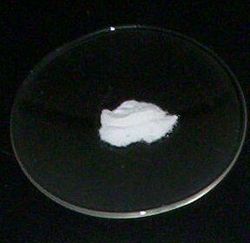 | |
 | |
| Names | |
|---|---|
| IUPAC name Caesium fluoride | |
| Other names Cesium fluoride | |
| Identifiers | |
3D model (JSmol) | |
| ChemSpider | |
| ECHA InfoCard | 100.033.156 |
| EC Number |
|
PubChem CID | |
| RTECS number |
|
| UNII | |
CompTox Dashboard (EPA) | |
| |
| |
| Properties | |
| CsF | |
| Molar mass | 151.903 g/mol [1] |
| Appearance | white crystalline solid |
| Density | 4.64 g/cm3 [1] |
| Melting point | 703 °C (1,297 °F; 976 K) [1] |
| Boiling point | 1,251 °C (2,284 °F; 1,524 K) (2,284 °F; 1,524 K) |
| 573.0 g/100 mL (25 °C) [1] | |
| Solubility | Insoluble in acetone, diethyl ether, pyridine and ethanol 191 g/100 mL in methanol. |
| Basicity (pKb) | −744 kJ/mol |
| −44.5·10−6 cm3/mol [2] | |
Refractive index (nD) | 1.477 |
| Structure | |
| cubic, cF8 | |
| Fm3m, No. 225 [3] | |
Lattice volume (V) | 0.2169 nm3 [3] |
Formula units (Z) | 4 |
| Octahedral | |
| 7.9 D | |
| Thermochemistry | |
Heat capacity (C) | 51.1 J/mol·K [4] |
Std molar entropy (S⦵298) | 92.8 J/mol·K [4] |
Std enthalpy of formation (ΔfH⦵298) | −553.5 kJ/mol [4] |
Gibbs free energy (ΔfG⦵) | −525.5 kJ/mol [4] |
| Hazards | |
| Occupational safety and health (OHS/OSH): | |
Main hazards | toxic |
| GHS labelling: | |
   | |
| Danger | |
| H301, H311, H315, H318, H331, H361f | |
| P201, P202, P260, P261, P264, P270, P271, P280, P281, P301+P310, P301+P330+P331, P302+P352, P303+P361+P353, P304+P340, P305+P351+P338, P308+P313, P310, P311, P312, P321, P322, P330, P332+P313, P361, P362, P363, P403+P233, P405, P501 | |
| NFPA 704 (fire diamond) | |
| Flash point | Non-flammable |
| Safety data sheet (SDS) | External MSDS |
| Related compounds | |
Other anions | Caesium chloride Caesium bromide Caesium iodide Caesium astatide |
Other cations | Lithium fluoride Sodium fluoride Potassium fluoride Rubidium fluoride Francium fluoride |
Except where otherwise noted, data are given for materials in their standard state (at 25 °C [77 °F], 100 kPa). | |
Caesium fluoride (cesium fluoride in American English) is an inorganic compound with the formula CsF. A hygroscopic white salt, caesium fluoride is used in the synthesis of organic compounds as a source of the fluoride anion. [5] The compound is noteworthy from the pedagogical perspective as caesium also has the highest electropositivity of all commonly available elements and fluorine has the highest electronegativity.


